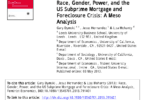The real estate collapse in America has brought about some interesting things which will live on, and culturally effect generations to come. From the redistribution of wealth to the legislative changes in the banking sector, real estate has become something very different from the what the norm past used to be. In particular, multi-generational residences have become very popular. This goes beyond the typical reality nowadays of college graduates perpetually living at home. Now, the typical household can consist of three, sometimes even four different generations of family members.
Contents
The New 2012 Households
After their four years away at college, most graduates used to swear off roommates forever. However, according to the US Census Bureau, roughly five million homes had three or more generations living under the same roof in 2010. In most cases, this was not necessarily by choice. This situation has always been much more common in other parts of the world. But, it has never been widely accepted by the aggressive real estate consumers in the post WW2 American age. Unemployment, at least in the broad spectrum, has been hovering around 18-20 percent since 2010. In many of these US households, the lack of stable income for the household members plays a big role in their reasons for living this way. If the funds were there, the younger adults would move out and the older adults would probably be in an retirement homes or their own apartments.
Multi-generational Statistics and the Future
Whether most people like it or not, multi-generational households are becoming so popular that builders are beginning to design homes to target this new growing market. For example, Toll Brothers decided to replace a portion of its family homes with guest suites and complex floor plans that used to be considered customized designing. These options are now turning into the mainstream in the real estate construction industry. Constructions companies are being directed to transform that second space in the two-car garage into a living area or guest room. Lennar, KB, and Pulte Group are three other homebuilders offering homes targeted for this growing demographic.
The Census Bureau report went on to show that what they term, “doubled-up households” have grown by leaps and bounds. These forms of households rose from 19.7 million during 2007, when the Great Recession began, to nearly 22 million by 2010. That’s a 10.7 percent increase, and this situation has only picked up speed in 2011 and 2012. Doubled-up households typically include one extra non-student adult that isn’t anyone’s spouse or life partner, but lives in the home anyway. In recent years, these “non-student” house guests in the 25-34 year old range, who are living at with parents and/or grandparents has seen a 25 percent increase.
Psychologically this is all new and disturbing to modern American families who have been conditioned to believe that all children leave the nest and purchase their own homes or apartments by the time they reach this age bracket. The self-help section of book stores, both print and digital, are increasingly offering tips and guides to make these types of living situations work. Household trouble becomes more prevalent in homes where men can’t find work, and young ambitious adults find themselves trapped without much access to financial freedom or independence.
It May Be Wise to Consider
Those that are doing and experiencing living in these households of multiple generations, now advise others to take the time to at least consider doing themselves. The majority of those who are experiencing aren’t necessarily living like this by force or necessity. They’ve taken the time to do their homework and have decided that it just makes more sense than spreading their incomes thin to live any other way. They’ve made their lists of pros and cons, which have been clearly written out, to weigh their options carefully.
Sometimes it’s a blessing, and sometimes it isn’t. For example, when young parents come into the mix, child care costs can be saved with the assistance of the non-working adults in the home. On the flip side, what if auntie or grandma may not want to babysit or be bothered with kids. There are plenty of grandparents who find themselves looking after their grandchildren when they were expecting to be out playing golf and traveling around the world, enjoying their golden years.
Multi-generational Real Estate Markets
The good news is that once the real estate market does rebound, and it will, as sure as the sun will rise, the multi-generational home and mindset won’t be so uncomfortable. A much larger portion of available homes will be have been developed to accommodate the multi-generational living situation. Homes within a home won’t be so hard to come by. And, because they’re not actually multifamily properties on paper, they won’t be subject to multifamily zoning laws and taxes. All kinds of features that would cost a hefty price in terms of private home improvement ventures will become normal additions to most homes on the market. Whether it’s smaller social spaces to make room for larger guest rooms, study areas that used to be elongated kitchens, or little spaces for shoe storage, the things that multi-generational families create on their own will become popular selling pitches in years to come.





